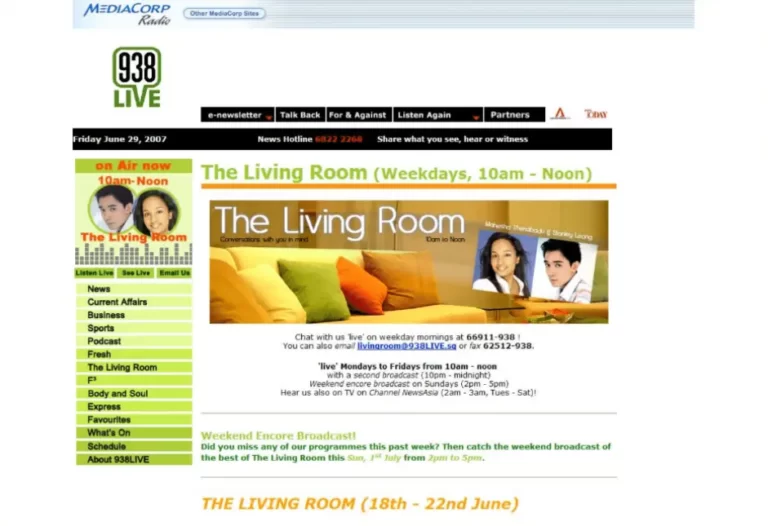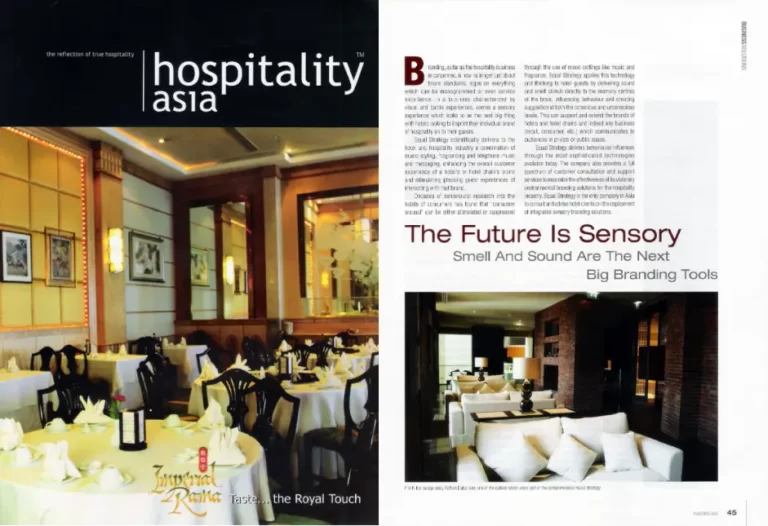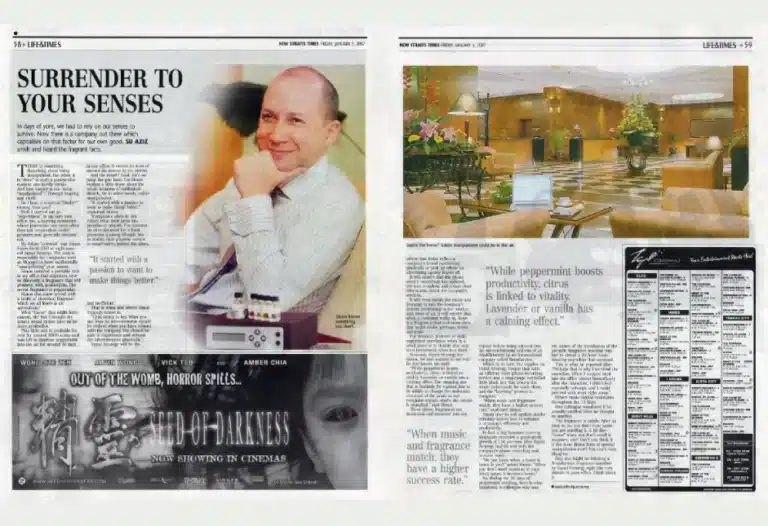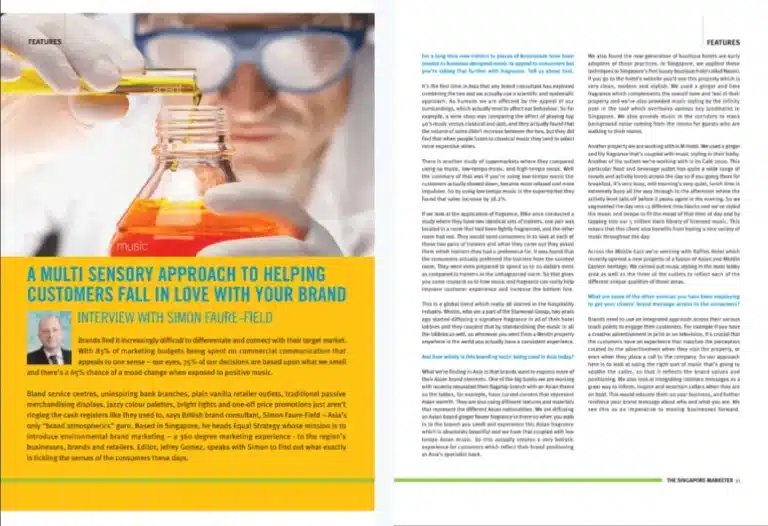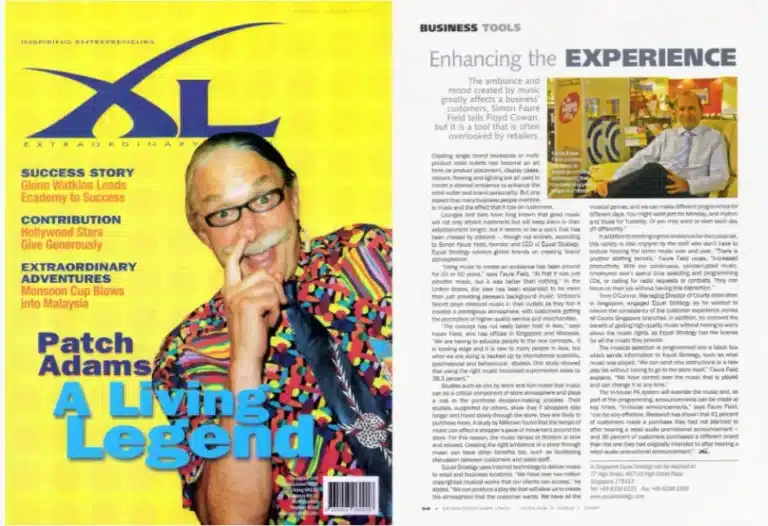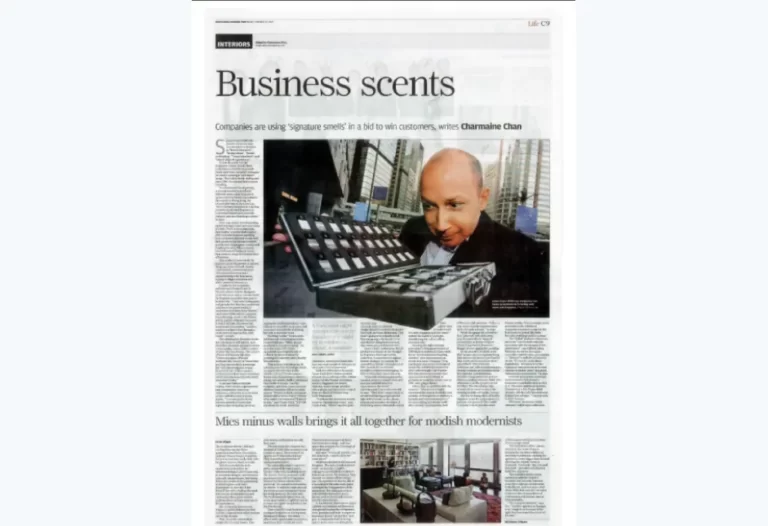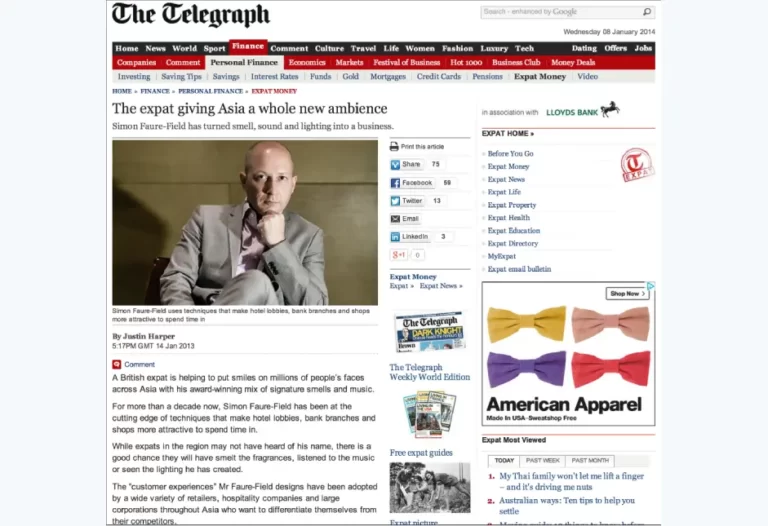Table of Contents
Channel News Asia – Prime Time Morning TV
Suzanne Jung and Steven Chia
Simon Faure-Field speaks to Suzanne Jung and Steven Chia about environmental branding and how Equal Strategy delivers ambient fragrances and background music to businesses in Singapore to enhance the customer experience of clients’ brands and encourage customers’ buying patterns.
Suzanne: Welcome back to the program. Well, the next time you walk into a shop, a bank, hotel or even a supermarket, you would do well to take note of the smells and sounds around you …
Steven: …Because chances are the more pleasant the environment, the longer you are staying and that means the more money you will spend.
Suzanne: That’s right and that’s precisely the catch. Retailers are now sniffing out a new technique that gives new meaning to the term “retail therapy”.
Steven: In fact, I can smell it right here, right now. It’s called “environmental branding“, and it is essentially about creating the ambience to encourage you to spend more money. And this morning we have someone to share with us more of this marketing strategy, Simon Faure-Field, brand advisor and brand enhancer. Good morning, Simon!
Simon: Good morning.
Steven: I could only smell some of the scents creeping out from that box you have over there. So, this is an example of some of the scents that would be in retail outlets? I mean how does it all work? Give us an idea.
Simon: Basically, what retailers are looking to do is to use background music and scent marketing as a new way to connect with their customers’ emotions, stimulate their behaviour, and create that emotional connection with the brand.
Suzanne: Are you saying that the smells will actually encourage this sort of behaviour, you know, just besides, “It’s a pleasant smell. It smells good.”
Simon: If you had an environment that was, for example, selling electrical equipment, and people associate with technology energy, excitement and adrenalin … so you’d want to be using a fragrance there that would be very refreshing and revitalizing,. That’s what we define as a high arousal fragrance. And of course we could also use high-energy music to go with that as well.
Steven: Give us an example. Maybe of companies and what they would be using. Give us a better idea.
Simon: In Raffles City we work with an art gallery called Ode to Art. They wanted to create a very sophisticated environment because they are selling big-ticket items. And it’s about creating the right sort of ambience. We are using a fragrance there called “Elegance”. So, if you would like to have a smell of that one …
Steven: How did you actually put it into the atmosphere?
Simon: Well, we have a system that takes a liquid fragrance, such as that, and we turn it into a dry vapor. And we connect that into the air-conditioning delivery system.
Suzanne: But isn’t it all subjective because what’s good, what’s nice, what’s not nice, what’s sophisticated, it all depends on, you know, the individual.
Simon: Totally. But there are associations that people will sort of associate with certain attributes. So, for example, Citroën. We have selected this one here called “True Star”. It’s very fruity. Let me get this one [bottle] open.
Steven: Citroën as in the carmaker?
Simon: Yes, the car retailer.
Steven: So where would they use this?
Simon: In the showroom.
Steven: In the showroom?
Simon: In the showroom. Even though new cars are sprayed with a new car aroma two weeks before they leave their factory, what we are looking to do in the retail outlet is use a fragrance that is vibrant and fruity.
Suzanne: You know some of us love that new car smell. Is that artificial or is that … How long does it last?
Simon: Six to eight months.
Suzanne: Ah hahhh …
Simon: Rolls Royce, they developed one because they found in their, I think their latest models didn’t have quite the same aroma inside the car as the Silver Shadow sort of like 30, 40 years ago. So they actually spray one under the seats in the car, which is a Rolls Royce fragrance.
Suzanne: Quick question. So, a car, that’s fine. It’s understandable, small space. But when we talk about big areas like shopping malls, where you want to encourage shoppers to spend more … I mean, it is a huge complex. How do you dissipate this aroma or, you know, have the smell work on them.
Simon: Same way. We don’t use little bottles of fragrance like this but we use a larger size equipment and then actually again use the same principle where the fragrance is turned into a dry vapor and that’s then pumped into the air-conditioning supply duct, which so it mixes with all the treated and cooled air that’s being distributed to specific areas.
This way we can actually create a very consistent and even fragrance level throughout the environment, not just for 5 or 10 minutes, but literally hour after hour, day after day, month after month. And we can even adjust the intensity within that environment.
Steven: Wow …wow …
Suzanne: Is there any proof that it works?
Simon: Definitely, clothing brand Nike did a study with Dr Alan Hirsch in the US a few years ago. They had two identical pairs of trainers, put them in two separate rooms and they actually sent consumers into each room to go and have a look at these trainers. One room had been lightly scented with a fruit themed fragrance. So light that to the nose you did not immediately notice it.
But when they asked the consumers afterwards, “Which trainers did you want to buy?”, they actually selected the ones that were being fragranced. When asked why, they didn’t know why. They just developed a natural subconscious preference for the trainer from the scented room and they were actually prepared to pay $10-15 to $20 more.
Suzanne: So, are you saying that when we go shopping, we are unconsciously being manipulated by these, I don’t know, strategies that are being put in place.
Simon: I think a better way to really look at that is if shops at the moment or retailers are currently focusing on visual arousal, preference or appeal. We have five senses. They are only looking at 20% of the appeal opportunity.
So literally what we are doing is, we are helping them focus on adding the right sound and the right fragrance. I think that actually being more customer-centric than people who aren’t looking to use background music and ambient scent. So, it’s not manipulation, it’s making it better.
Steven: If you really think about it, it is fairly basic. Sure, you want to go to a shop that is clean and fairly nice looking. And if a shop doesn’t smell appealing, you are not going to stay. So if it does smell appealing, you kind of stay. You kind of look at the reverse. Not the glass is half-empty but the glass is half-full, then it all makes sense.
Simon: That’s right. The nose is the only sense that is directly connected in the brain center for memory and emotion. And it is actually the most powerful sense as well. Because if you walk in somewhere, no matter how nice it looks, if it doesn’t smell right, you are not going to want to stay there.
Steven: Well, what happens then if I have this scent that I remember from a certain shop, and I go in another shop that sells something totally different but it is the same smell? How is that, is that going to work against …?
Simon: That’s possible, right. We also develop signature fragrances. So, for example I have the Shangri-La fragrance here. That’s actually used in all of the Shangri-La business hotels in Asia. And if you have a smell of that … How do you find it …?
Suzanne: Smells like … a very familiar smell, actually.
Steven: Now that I am smelling it, I am thinking, “Where do I remember it from? Okay, okay, this is something that only the Shangri-La would have.”
Simon: Correct!
Suzanne: And it gives you a déjà vu feeling, which is always a nice feeling. But let’s talk about background music because you mentioned about ears as well. What kind of music, just generalising the whole thing, will add to shopping experiences? What kind of ambient music will be added to different kind of surroundings.
Simon: Okay, a couple of thing what we like to do when working with our clients is, objectively, what do they want to achieve within that environment? So, Courts in Singapore, which is one of Singapore’s successful retailers, when they opened their Mega Store, for the electrical department, they wanted to create a vibrant atmosphere and used a high energy music arrangement.
We curated a music profile that had high beats per minute because that tempo helps stimulate people within that environment. Yet if you go into the furniture department they wanted people to slow down and relax, so we use low tempo background music. And that low tempo music can come across different genres, from Jazz to Chill Out to some New Age to Ambient. So we can look into music tempo as a way to stimulate the emotions and movement of people.
Steven: That kind of suits the environment as well. Now that being said, we have to ask you, what about the cost? Does it makes sense at the end of the day, for example, for a small retailer. They’ll say, “Does it makes sense for me?”
Simon: Definitely. If you can create an environment where your staff like to be working, that actually helps with your recruitment costs and also improves your staff retention. That has a significant impact on the business. But then also looking at if from top-line revenue, if you create an environment where your customers naturally prefer to go, you’re creating there a subconscious brand preference.
Suzanne: But for the more pleasant experience, will that cost be transferred back to us consumers.
Steven: I think that’s the whole idea.
Simon: No, because with you actually being there and spending more time there, their revenue will actually increase without having to increase the number of customers visiting that store. So they actually become more profitable. There is a better profit margin.
Steven: And you already gave an example previously with the Nike shoe, right? Without even knowing, we are already paying 20% more, so it’s all in the package. You don’t know what’s happening, that’s all.
Suzanne: Thank you for coming in this morning.
Simon: Lovely. Thank you.
Suzanne: We’ve been speaking to Simon Faure-Field from Equal Strategy on environmental branding. It’s a new style marketing strategy that’s out to get you in the mood to buy, and of course spend more of your money. But it’s an all-around pleasant experience.
Steven: You know what you could do, if you really want to buy only one thing and not allow yourself to be distracted, then you go in there, plug in your own music, put a peg on your nose —
Suzanne: Hey, you’re taking the joy out of retail therapy!
Steven: — and then you’re just going to buy that one thing. You just want to make sure you don’t get distracted, that you don’t linger on, and you can be very focused. Wear your shades and say, I’m just going to buy that one pen.
Suzanne: We’re going to come back with more on Prime Time Morning. We’ll see you in just a bit.


